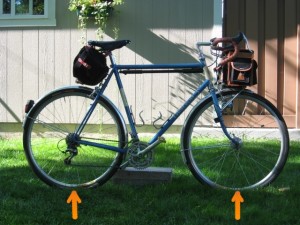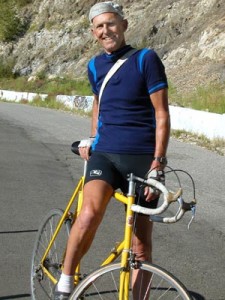Even though I’m a fan of steel bikes, it’s mostly because of the durability of the material. I certainly like the ride quality too, but I think the idea that steel is a more plush or forgiving ride because it flexes or dampens is hogwash. The idea has almost become gospel now just because it’s been repeated so many times. Don’t get me wrong, I know my steel bike frames flex…. I can hear my fender and/or brake and/or front derailleur rub from time to time if they are a little out of whack and I am pressing hard on the pedals. But that is torsional flex.
It’s the idea of vertical flex of a bicycle frame I have a hard time envisioning.
Imagine the arrows to be balancing the downward force of the rider and the bike. When the rear wheel hits a bump some of that movement will be absorbed by the tire and wheel. Some movement gets transmitted to the bicycle frame at the point where the rear wheel attaches to the bike. This is one corner of a triangle made out of rigid, straight tubes with rigid joints. A triangle is a strong shape. And, there are actually two triangles – formed by the seat stays and the chain stays on either side of the wheel. For those triangles to flex, the tubes would have to bend. I can see it if the seat stays are designed like this:

But I can’t see straight seat stays loaded in pure, inline compression contributing much to shock absorption .
The front end is a different story. The wheel is attached to the fork which has some bend or rake to it. Obviously, that is designed to flex or dampen.
I had the great privilege of meeting Jobst Brandt at Interbike earlier this year.
Jobst Brandt is a mechanical engineer (Stanford) with extensive experience, having worked for Porsche automobiles, Stanford Linear Accelerator Center, Hewlett-Packard and Avocet bicycle products.He is best known in the bike industry as the author of The Bicycle Wheel , the definitive text on the theory and practice of building spoked bicycle wheels.
In his book, Mr Brandt shows a diagram of the forces acting on a bicycle wheel as it is being ridden. The wheel actually deflects quite a bit and absorbs a good deal of the energy or movement when the bicycle hits a bump.
This doesn’t even take into consideration the fact that there will be a tire on the wheel which will also deflect and absorb a good deal of the impact.
My point is this:
Wheels, tire size and inflation, and bike geometry will play a more significant role in how “comfortable” a bike is and how “plush” the ride is than the material used to make the frame. A carbon or aluminum bike with longer chain stays, to put the wheel farther behind the rider, and with clearances for wider, cushier tires could ride as nice as any steel frame, and by the same reasoning it’s possible to build a steel frame that will rattle your fillings..




